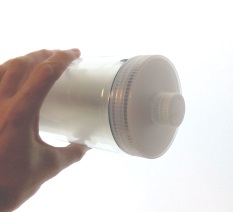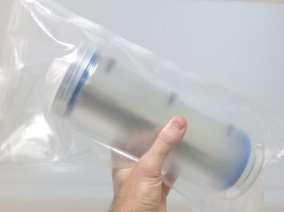The Roller BoB
|
The Roller BoB is a large capacity device for the culture of adherent cells. This system is a simplified version of the full BoB and allows for a several fold increase of productivity using a traditional roller. The Roller BoB is compatible with standard rollers for roller bottles. The current version, available for evaluation, provides 13,500 square centimeters of a smooth and continuous cell adhesion area in a total volume of 1.5 liters. External dimensions of the device are, aproximately, 10 cm in diameter and 25 cm in length. |
 |
Roller BoB description
The evaluation units of the Roller BoB consist of a smooth and continuous surface for cell adhesion with the shape of a spiral (the cell culture support) contained in a cylindrical vessel. The succesive turns of the support coil are separated from each other to allow liquid flow and gas exchange between the turns. Thus, a total culture area of 13,500 square centimeters is available in the cell culture support.
The Roller BoB differs from the Bolt-on Bioreactor in the way the spiral support is rotated. When the Roller BoB is placed horizontally in a roller, a slow rotatory movement drives the culture medium contained in the lower part of the device towards the inner turns of the spiral. The volume of culture medium exceeding the capacity of a given turn during operation, flows out of the spiral and back to the bottom of the culture device. The same happens to the volume of culture medium reaching the center of the spiral. On every turn of the Roller BoB culture medium in the bottom of the device is re-introduced into the spiral and driven to the center of the support.
How to use the Roller BoB
The Roller BoB is provided sterile and ready-to-use.
Open the protecting bag and extract the device. Open the screw-cap in a clean environment and introduce the cell suspension at the desired concentration. Close the lid and place the Roller BoB on a roller within a cell culture incubator. Make sure the Roller BoB is seating perfectly horizontal on the roller. Open slightly the screw-cap to allow for gas exchange. You can, optionally, secure the cap with a piece of adhesive tape. Set a sufficiently rapid rotation speed for some minutes to achieve an even distribution of the cell suspension throughout the support before cells attach to the support. Reduce rotating speed to the right value for the culture of your cells. Replace the culture medium as required. To do this, close the lid of the Roller BoB and transfer it to a clean environment. Pour out the exhausted culture medium and introduce fresh culture medium. Put the Roller BoB back on the roller.
Operating parameters
Every cell line and production process will require investigation of optimal operating parameters.However, you can consider the following experimental conditions and the results obtained, as a reference.
A 200 ml of DMEM/F12 50:50, 10 % FBS culture medium containing 13.5 million CHO cells in were poured inside a Roller BoB. The device was rotated at 10 rpm for 10 minutes and then the process continued at 0.25 rpm. Every two days, 160 ml of supernatant where replaced with fresh culture medium. After six days, the supernatant was discarded and the cells where harvested by trypsinization with 200 ml of a trypsin solution in PBS. During trypsinization, a rotation speed of 25 rpm was applied. The number of recovered cells was measured under a microscope.
From this experiment we obtained 492 million cells.
The initial seeding (13.5 million cells) was equivalent to 1,000 cells per square cm of support and we recovered more that 36,000 cells per square cm of support. The average doubling time for the cells was 1,14 days. Since a common thumb rule is that 100 % confluency is reached at about 100,000 cells per square cm, we can speculate that total confluency at the harvest time was about 36 %, being necessary an additional two days (an eight-day culture) to reach 100 % confluency at the test conditions.
 |
 |
© Copyright 2014 - 2019, The BoB project
